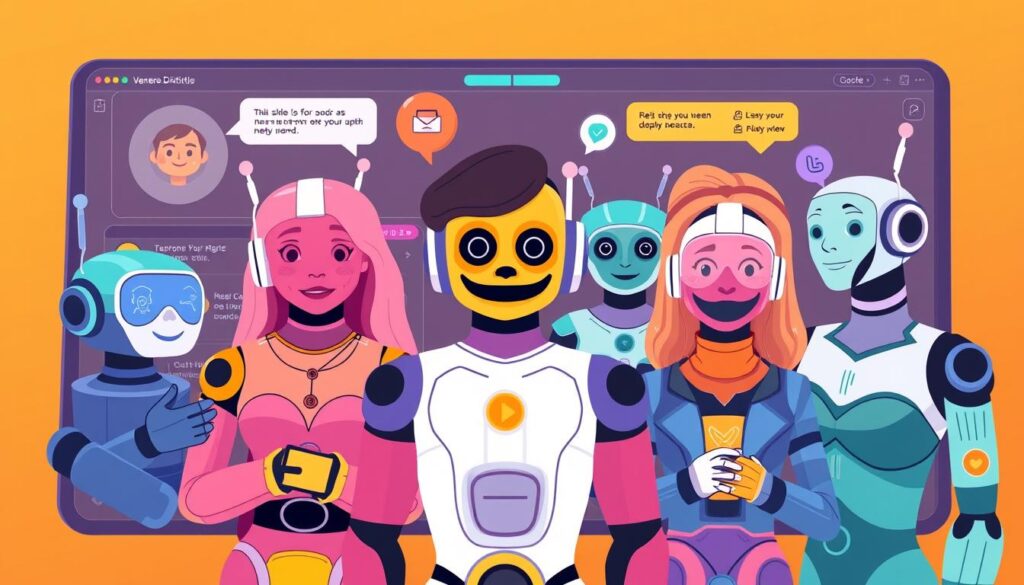Did you know that good chatbot design can boost user engagement by up to 80%? As more brands use automated chat, knowing how to design chatbots is key. A well-made chatbot makes talking to it easy and enjoyable, making users happy and loyal.
This part talks about why good chatbot design is important. It shows how it can really make a difference in how users feel. It’s all about making Conversational AI better for everyone.
Understanding the Importance of Chatbot Design
Chatbots are key in today’s fast world. They help businesses talk to their customers. They give quick answers that make users happy.
Chatbots do more than just automate. They change how companies talk to people.
The Role of Chatbots in Modern Communication
Chatbots connect companies and customers. They make talking easier. With good chatbot design, users get help fast.
This quick help makes users feel they can trust the company. It makes them want to talk more. Happy users are loyal users.
Benefits of Effective Chatbot Conversations
Chatbots bring many benefits to businesses. They offer great customer service, working all day and night. This meets users’ need for quick help.
Good chatbot talks help users feel understood. They meet users’ needs in a special way. This builds strong connections and success for businesses.

Fundamentals of Conversation Design
Good conversation design is key to chatbot success. It makes sure users enjoy talking to them. Designers use clear, short messages and think about what users want.
They make sure it’s easy to find what you need. This makes users happy and keeps them coming back.
Key Principles of Conversation Design
Following Chatbot UX principles is crucial. Clear answers help avoid confusion. Short messages are easy to read.
Designing with the user in mind makes chats better. Making the flow of conversation smooth is important. This way, chatbots meet many needs well.
Designing for User Experience
User experience is very important in chatbot design. It’s about knowing how people use tech and what they want from chats. Using Chatbot UX principles makes chats fun and useful.
When developers focus on user experience, chats are better. The goal is to make finding answers easy and fun.

Identifying User Needs and Goals
Understanding what users need is key to making great chatbots. We start by doing lots of research to learn what users want. This makes sure the chatbot meets their needs and offers useful talks.
Conducting User Research
We use interviews, surveys, and tests to find out what users need. This helps designers make chatbots that really meet user needs. By understanding what users like, brands can make things that truly connect with people.
Defining User Personas
Creating chatbot personas helps show who users are. These personas show different types of users and what they expect. This way, designers can make chatbots that users will love and use more.

Creating Intuitive Conversation Flows
To make chatbots better, we need to create easy-to-use conversation flows. These flows help users move smoothly and understand what’s happening. This makes talking to chatbots more fun and engaging.
It’s important to plan out how conversations will go. This means making sure talks make sense and help users get what they need. Clear conversations help users reach their goals easily.
Mapping Out Dialogue Structure
Designing good conversation flows starts with mapping out dialogue structures. This means seeing how users might talk to the chatbot. A good plan helps predict what users will say next.
This lets developers make flows that feel natural. Using flowcharts and diagrams helps teams see how users will interact with the chatbot. It makes designing easier.
Utilizing User Feedback in Flow Design
Using user feedback is key to making conversation flows better. By listening to what users say, designers can spot problems and fix them. This makes the chatbot more user-friendly.
By making changes based on user feedback, we can keep improving. This way, the chatbot meets user needs better and better.

Designing for Different Platforms
Chatbots need to work on many platforms. Each one has its own design needs and challenges. Making chatbots for websites or messaging apps requires knowing what users want. This makes the chatbot better for each place, improving how users interact.
Integrating Chatbots into Websites
Adding chatbots to websites is all about user experience and ease of use. The chatbot should fit well with the website’s design. It should help users quickly, without making them feel overwhelmed.
Designing an easy-to-use interface is key. This lets users find what they need fast. It makes the chatbot feel like a helpful tool, not a hassle.
Conversational Design for Messaging Apps
Designing for messaging apps is different. It’s all about being quick and friendly. Users like fast, friendly chats that feel like talking to a friend.
Using simple language and fun features like buttons helps keep users interested. Knowing how messaging apps work helps designers make chats that users love. This leads to better communication and happiness.

Scriptwriting for Chatbots
Making chatbots talk well needs creativity and skill. It’s about writing scripts that users love. The goal is to make chatbot talks feel real and friendly.
Crafting Engaging Dialogue
Good chatbots talk in a way that makes users want to chat back. They should sound like the brand but still be easy to talk to. Using fun and caring words makes chats enjoyable.
Scriptwriters should think about what users want to say. This way, the chat stays interesting and on point.
Incorporating Brand Voice and Tone
Keeping the brand’s voice and tone is key in chatbot design. It builds trust and shows who the brand is. Scriptwriters need to match the brand’s style to make users feel connected.
Leveraging AI and Machine Learning
AI and machine learning change how chatbots talk to users. They make chatbots better at understanding what users want. This lets chatbots give answers that fit the situation.
Thanks to NLP, chatbots can get the real meaning behind what users say. This makes their answers more accurate.
Enhancing Conversations with AI
AI makes chatbots smarter over time. They learn from every chat and get better at answering. This means they can understand what users like and need.
Users feel like chatbots really get them. This makes talking to chatbots more fun and helpful.
Understanding Natural Language Processing
NLP is key for chatbots to talk like humans. It helps them understand and respond to what users say. This makes chatbots more useful and friendly.
As tech gets better, NLP helps chatbots even more. They stay good at talking to users in many situations.
Testing and Iterating the Chatbot Design
Creating a good chatbot needs constant checking and making it better. It’s key to use strong testing methods to find problems and make users happy. Getting feedback from users helps make the chatbot work better and solve any issues.
Importance of User Testing
User testing is very important in making the chatbot better. Real people’s feedback shows what needs fixing. Watching users talk to the chatbot helps designers see what’s not working right.
This helps make the chatbot easier to use. It makes the experience better for everyone.
Continuous Improvement Strategies
Using user feedback to improve is important. Ways like A/B testing and updates based on data help a lot. These steps make users happier and keep the chatbot useful.
Emotional Intelligence in Chatbot Design
Adding emotional intelligence to chatbots makes talking to them better. They can understand how we feel and show empathy. This makes them more relatable and personal.
Adding Empathy to Conversations
Empathy is key for good talks. Smart chatbots can pick up on our feelings from what we say or how we say it. They then respond in a caring way, making us happier.
When chatbots really get what we mean, we feel heard. This makes us want to talk more. It’s like having a friend online.
Recognising User Sentiment
Chatbots can now understand our feelings better. They look at how we feel and change how they talk to us. This makes our chats better and more meaningful.
Being able to sense our mood makes chatbots more useful. They become a go-to for many businesses. It’s all about making our online chats better.
Ensuring Accessibility in Conversation Design
Accessibility in chatbot design is key. It makes sure everyone can use technology easily. This includes people with disabilities.
Adding accessibility features helps everyone. It makes technology more inclusive for all.
Adhering to Accessibility Standards
Following W3C standards is important. It makes sure chatbots are accessible. Features like text for images and keyboard use improve the experience.
These standards help users with disabilities. They make chatbots more inclusive.
Creating Inclusive User Experiences
Designing for everyone is more than following rules. It’s about thinking about all users’ needs. Features like voice recognition and customisable interfaces help.
By considering different views, designers create better chatbots. This leads to a better experience for everyone.
Measuring Engagement and Success
In chatbot design, knowing how well it works is key. This comes from looking at how users interact with it. By using the right metrics, designers can see if chatbots meet user needs.
They can then find out where to make things better. This helps in making chatbots more engaging for users.
Key Performance Indicators for Chatbots
Metrics like how often users come back, how long they stay, and if they finish what they started are important. They show how well chatbots work. By using these, designers can make chatbots better and more user-friendly.
This makes users happy and helps chatbots work better. It’s all about making sure chatbots meet what users want.
Analysing User Interactions for Improvement
Analytics are vital for making chatbots better. By studying how users act, designers can make changes. This makes chatbots more user-friendly and better at meeting user needs.
It’s all about making sure chatbots are easy to use and meet user expectations. This leads to better experiences for everyone.
